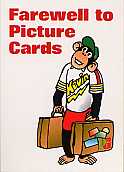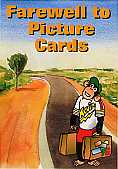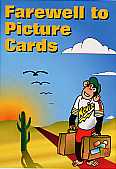I (Lee Towersey) run this site on behalf of my Mum (Judith Towersey) who
has been a Brooke Bond collector & dealer for a number of years.
Coincidentally one of my Dads (Mike Towersey) first jobs was delivering Brooke
Bond Tea!

In 1869 Arthur Brooke opened his first shop with his £400 savings.
Called 'Brooke Bond & Company' there was no 'Mr Bond': the name 'seemed to
him to sound well'. His shop opened at 29 Market Street, Manchester, England,
selling tea, coffee and sugar only - for cash over the counter. His first cash
book still exists, and shows that he made a profit in his first week by putting
his own share back into the business.
The story goes on, and we continue with how cards were introduced and how
advertising and promoting of Brooke Bond built the company to where they are
today.
With the ending of tea control in 1952, Brooke Bond in Britain entered a
period of real challenge. In the preceding years, profits had been carefully
husbanded so that at this moment the company was well balanced to take
advantage of the situation. It was a question of who was awake and ready and
who was still asleep on the day tea rationing ceased. The Brooke Bond sales
team led by Vernon Blackwell and supported by all the firm's reserves and
manpower had in fact been ready and raring to go with all campaigns worked out
for some considerable time.
The moment coincided with the election of a new chairman - John Brooke. With
his deputy chairman, Thomas D Rutter, and the salesroom in the hands of two
tried and experienced tea men, Leslie Gray and Cyril W Dudley; the company
finances managed by Laurence Green and Conrad Warner; and the sales side under
the direction of Vernon Blackwell assisted by Wilfred Payne and A D Dorrington,
John Brooke had a staff that mingled tradition and imagination, innovation and
reliability.
In the next decade, the most striking developments were in the competitive
fields of advertising and promotion. First a series of colour advertisements in
magazines depicted tea cultivation and production and told 'The Story of Tea'.
For the Coronation of Queen Elizabeth II in 1953 it had been planned - as at
previous coronations - to produce appropriately decorated canisters of tea. At
almost the last moment, metal shortages made this impossible. With customary
Brooke Bond ingenuity, Vernon Blackwell inaugurated 'coronation tea parties'.
In exchange for thirty packet wrappers, the organisers of street tea parties
throughout the country were given a contribution towards the cost of the
festivities. (In 1969 there was no such shortage to prevent production of
decorated canisters to commemorate the investiture of the Prince of Wales at
Caernarvon.)
Berkshire Printing produced a million Union jack paper hats, bearing the
company name. It seemed that all the children in Britain were celebrating the
new era. In 1954 another successful promotion was launched. Before the war,
cigarette cards had been collected in their millions - small rectangles of
coloured pasteboard inserted in cigarette packets. The tobacco manufacturers
had not reintroduced the cards after the war. Now Brooke Bond inaugurated
'picture cards'.
Enquiries among leading printers produced no response. It seemed that
British printers had lost the capacity or the wish to print such cards. So the
job went to the Berkshire Printing Company who, starting from scratch, made a
fine job of printing many millions of cards to the highest standards of colour
work. Neville Brooke and Phillips Engineering devised a mechanical method of
inserting the cards in tea packets. The first series of picture cards, their
subjects drawn from natural history, were produced with the assistance of the
eminent naturalist and author Miss Frances Pitt and illustrated British birds.
Further series followed, on such subjects as wild flowers, astronomy, fish,
butterflies and African and Asian wild life. Later, transport, the motor car,
and British costume were added. The Brooke Bond picture cards established
themselves rapidly as collectors' favourites and as educational aids, and by
1968 the annual distribution of the cards had topped 720 millions.
Another major promotion was introduced in 1955. Following the success over
many years of local schools competitions organized by Brooke Bond, a National
Schools Competition of art and essay-writing was launched, with a judging panel
of headmasters, and a first prize of a journey to the tea estates of East
Africa, India or Ceylon.
A most attractive series of advertisements illustrated in finely drawn
pictures, the 'little red vans' round and about in the towns and cities of
Britain, and also became collectors items.
The pressure of space in the old Goulston Street headquarters had now become
unendurable and in December 1956 the head, office and salesroom moved into a
new block Watling House, Cannon Street. Thus Brooke Bond returned to the City
of London. That year also, the company made a new agreement with Bushells Pty
Ltd., the largest tea and coffee distributors in Australia and New Zealand, to
supply bulk tea. Brooke Bond also provided substantial new capital for the
Australian Company and obtained a twenty per cent interest in it.
With the inauguration of independent television in Britain in September
1955, Brooke Bond became one of the early companies successfully to exploit the
advertising possibilities of the new medium. The company had already achieved a
high reputation for the quality of its advertising films, mainly documentaries
based on the growing of tea. It was Bill Barter of Spottiswoods the advertising
agents - whose chairman was R G Morris - who suggested that chimpanzees might
be employed to make an amusing and unusual television commercial. The first
advertisements appeared in 1956 at Christmastime. Chimps were associated with
tea: over many years the 'chimps' tea party at London Zoo had been an unfailing
attraction for children. The first two television commercials for Brooke Bond -
'Stately Homes' and the 'Chimps Tea Party' - were made by the Marquis troop of
chimps trained for cabaret by Gene Detroy. A further series followed using
chimps recruited from Billy Smart's circus. These commercials became
tremendously popular, with voices provided by Peter Sellers, Bruce Forsyth and
Bob Monkhouse.
Soon the Brooke Bond chimps were in demand for public appearances. George
Cansdale of the London Zoo enabled the company to discover the chimps owned and
trained by Miss Molly Badham, and these began to make merchandising tours round
the country, drawing huge crowds as they 'helped' to open supermarkets and new
stores.
On a more domestic occasion - a Brooke Bond staff party to mark Miss Lilian
Bristow's retirement as advertising manager - Johny, Judy, Sam and Rosie proved
most charming guests. Rosie, in particular, was found to have a feminine
weakness for gin and orange, and almond icing.
The Brooke Bond chimps certainly sold more tea. Their television commercials
were carefully linked with point-of sale promotions in shops and stores. By
1957 the advertising budget was £680000 but this was more than offset by
increased sales: the company could claim that one in every four families in
Britain was drinking Brooke Bond tea. The chimps appeared live at Saturday
morning film shows staged by the company's own projection units, which, during
weekdays and evenings, showed documentaries to schools and women's and other
institutes all over Britain.
As the number of supermarkets increased, so did 'point-of sale' advertising
methods - dump bins, in-store promotions, tea avenues and 'mobiles' often
featuring coloured cut-outs of the birds and animals then illustrated in the
picture card series. The notable success of these advertising and merchandising
methods is a tribute to Vernon Blackwell, whose ten years as sales director
were marked by a triumphant increase in sales in the most competitive period of
the company's history. The secret was in the efficient linking of vigorous
advertising with skilled sales distribution geared to cope with increases in
demand and factory production.
By 1958 the capital value of Brooke Bond had reached £30 million and
the company held almost thirty per cent of the packet tea market in Britain. At
that time the Monopolies Commission investigated the whole tea trade without
finding anything wrong with it. Learning then that 33.1/3 per cent of the
packet tea trade would make Brooke Bond a monopoly, John Brooke made this the
immediate sales target for the home business.
New sales depots were required. Many of the smaller depots were combined to
form larger units and the company embarked on a substantial programme of depot
rebuilding, introducing a number of mechanical aids. New factories were opened
at Bristol and at Redbourn, Hertfordshire (also responsible for Crown Cup
instant coffee, launched in 1963. Later an extension was completed at the
Trafford Park factory and the last bomb-damaged premises in Aldgate were
rebuilt.
The heavy vehicle fleets, used to transport tea from factories to depots,
were gradually replaced. The new vehicles, carrying at least 19200 lb. of tea,
were equipped with hydraulic tail lifts. This, combined with pallet loading,
led to faster off-loading at depots and a more efficient turn-round of the
vehicles themselves.
More mechanical aids were introduced into the factories, many of them
produced by Phillips Engineering Ltd., a Brooke Bond subsidiary then in
Birmingham and now in Weston-super-Mare. Among these aids was a jar cleaning
machine and an automatic tea-chest-opening machine. Phillips has now expanded
to be much more than just a service company for Brooke Bond: it produces
reel-fed printing machinery, and also precision engineering work for the motor
and aircraft industries.
Many major developments took place in the 1960s. Until this decade, it had
not been company policy to enter the tea-bag market. But now Brooke Bond began
to produce teabags, and within a few years reached second place in the British
market.
At this time vending machines came into greater use, particularly in
factories and offices. Brooke Bond catering service, which was until then an
offshoot of the retail sales force, now came under separate management. A
comprehensive catering and vending service was introduced providing tea,
coffee, chocolate and cups; later the production range was enlarged to embrace
control packs for caterers (coffee, instant coffee, tea-bags), vending sugar,
soups, beef extracts, milk and cold drinks.
Until the 1960s Brooke Bond had been principally a commodity company. But
now, in association with Tenco, a subsidiary of Coca-Cola, the company launched
its own research laboratories at Blount's Court, near Reading. There is another
research laboratory at Kericho, Kenya. A new factory costing £2 millions
was built at Bedwas, near Newport, Monmouthshire, to manufacture freeze-dried
instant tea and other instant foods.
By 1965 the size and scope of all these operations called for a new company
structure on modern lines, and the home sales side was turned into a separate
company, Brooke Bond Tea limited, with a greater degree of autonomy. Shortly
afterwards the parent company branched into yet another field of the tea trade.
While its reputation had been built on the marketing of good quality teas at a
reasonable price, Brooke Bond was often regarded as particularly associated
with the mass market. In 1967 four named quality teas were put on the market by
mail order at £1 a lb. Later six superb coffees packed in half-pound
vacuum-sealed tins were also introduced.
The expertise of another Brooke Bond subsidiary was particularly useful in
these new launchings. This was the Priory Tea and Coffee Company Limited, which
for years had blended and packed tea and coffee under proprietary brand names.
Today Priory handles more than 30% of the roasted and ground coffee market in
Britain, and has also successfully launched in the United Kingdom Blue Ribbon
spices (at first manufactured by Brooke Bond Canada Ltd.) and packed by Priory
themselves in London.
Through the 1960s Brooke Bond continued to take a larger share of the
British tea market, and also to support the Tea Council's promotion, 'Join the
Tea Set', which aimed to increase the market as a whole.
Overseas, Brooke Bond Exports began to have a marked success, particularly
in the West Indies. Indeed, the company could claim to be in the tea business
round the world. In Japan, there was an agreement with the Japan Black Tea
Company, an associate of the mighty Mitsubishi, and travellers on the most
modern train in the world, the Tokaido line, drink Brooke Bond tea. Passengers
on the Metroliner supertrain between Washington and New York drink coffee
supplied by Ehlers, a division of Brooke Bond Foods Inc, which also has a
valuable spice trade in New York.
Brooke Bond had long since passed the CWS weekly sales total of packet tea
in Britain and in 1966 were double brand leaders with PG Tips and Dividend tea'
'Triple Divi' was introduced in 1967 to join the Dividend range, and PG Tips
'the tea you can really taste' - had moved forward to become the market leader.
In 1968 a special promotion in connection with PG Tips offered the ten winners
a reunion with any friend or relative anywhere in the world. There were five
hundred prizes of telephone calls to friends or relatives anywhere' in the
world for the runners up. The competition attracted 1500000 entries from 900000
people, and added 30 per cent to the sales of PG Tips. The 'Happy Reunion'
contest won for Brooke Bond the M S Surveys 'Promotion of the Year' award.
Another successful promotion was at EXPO '67, the World's Fair at Montreal,
where two London buses provided by Brooke Bond proved an attraction for
visitors from all over the world.
In 1968, by its merger with Liebig, Brooke Bond became joint owners of
2684428 acres of cattle ranches in Argentina, Paraguay and Rhodesia - a
pleasant instance of history repeating itself, though this time appropriately
on a much larger scale.
Liebig's Extract of Meat Company Limited was incorporated in London in 1865
- four years before Arthur Brooke opened his shop in Manchester. It had been
founded to manufacture meat extract, the invention of Baron Justus Von Liebig,
the pioneer organic and agricultural chemist. The place chosen was near a town
called Fray Bentos on the River Uruguay, where cattle at that time were
slaughtered solely for their hides, the carcasses being left to rot on the
plains. According to local tradition, the town was named Fray Bentos by
visiting sailors, after a pious old hermit who lived there - Friar Bentos.
The company has greatly expanded in a hundred years, both in ranching and in
selling manufactured products, most of them based on beef. Today, Liebig owns
meat-canning and freezing factories in the Argentine, Paraguay and Rhodesia; a
similar factory is operated jointly with the Government of Tanzania, and there
is a minority shareholding in a meatcanning factory in Northern Nigeria. Liebig
has agreements with government agencies in Kenya, Botswana and Uganda for
supervising the manufacture and marketing of canned meats.
There are Liebig companies in the United Kingdom, Canada, South Africa,
France, Belgium and Italy, producing meat and chicken cubes, stock tablets,
beef drinks and liquid bouillons, together with canned convenience foods. There
are also distribution companies in Holland and Spain. Liebig products are all
marketed under various brand names, of which the best known being Oxo, Fray
Bentos, Lemco, Liebig and Viandox.
On its centenary, Brooke Bond by merging its operations with those of Liebig
gained additional assets in Africa and a considerable stake in the expanding
markets of South America, as well as new outlets in Europe. The merger produced
a company, Brooke Bond Liebig, that is one of the largest food manufacturing
and distributing companies in the United Kingdom, with interests spanning the
whole world.
All text on this page in non-italics taken from 'Brooke Bond 100 Years'.











